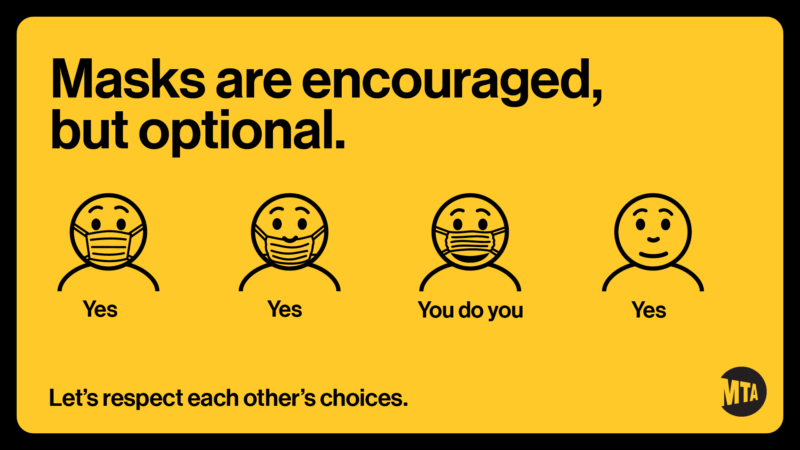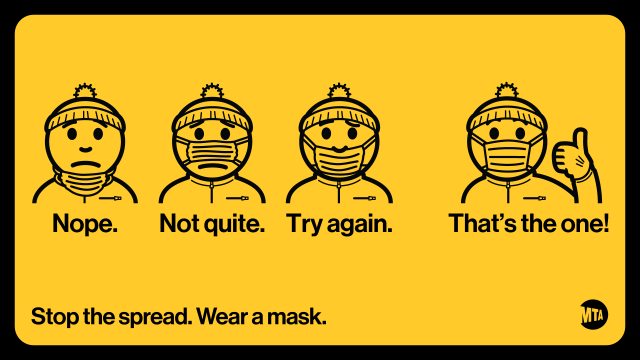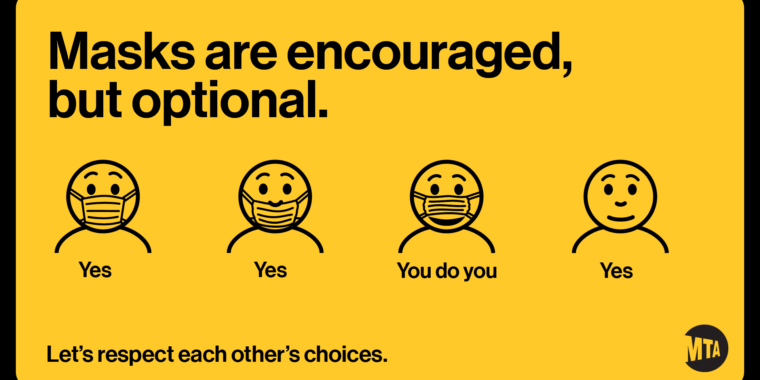
New York’s Metropolitan Transportation Authority faced immediate backlash Thursday after unveiling a new mask-optional policy featuring the tagline “You do you” below a silly cartoon of a person improperly wearing a mask over just the nose, not the mouth.
Generally, the new policy lifts the MTA’s previous requirement that riders wear a face mask—properly. Earlier signage showed a cartoon person correctly wearing a mask, with the tagline “That’s the one!,” after several examples of how not to wear a mask, including over just the nose. The requirement and the sign came with the slogan: “Stop the spread. Wear a mask.”

But the new guidance dramatically flips the collective-effort messaging to a more individual-based approach to public health, with the slogan: “Masks are encouraged, but optional. Let’s respect each other’s choices.” The new signage repeats the same cartoon examples of how not to wear a mask for protection, but now labels them all as acceptable.
In a statement, MTA Chair and CEO Janno Lieber said that “now is the right time for New Yorkers to make personal choices about what works best for them.”
MTA Acting Chief Customer Officer Shanifah Rieara added, “Customers should continue to do what they are most comfortable with while riding public transit whether that means wearing a mask or not.”
The emphasis on personal choice is in stark contrast to what public health experts and New York officials have long promoted, including the common refrain “we’re all in this together.” On Thursday, Governor Kathy Hochul tweeted that, starting today, “masks will be optional in some places where they had previously been required, including on mass transit.” Masks are still required in other places, such as healthcare settings, and policies could be adjusted as necessary in the future. She ended by saying: “We are still in this together.”
“A low point”
Health experts and Twitter commenters quickly mocked and criticized the new messaging.
“Nothing says ‘we’re in this together’ like ‘you do you’ on public safety messaging,” cosmologist Katie Mack replied on Twitter.
Infectious disease expert Louise Ivers—director of the Harvard Global Health Institute and director of the Massachusetts General Hospital Center for Global Health—called the “you do you” tagline “a low point” in the pandemic response. “[I] am aghast at the state of public health communication,” she added.
Former US Surgeon General Jerome Adams echoed the disappointment in the MTA’s new messaging. “No matter your feeling on masks, this is just terrible (and harmful) messaging,” he tweeted. “It either reflects a health person trying to be too cute… or a [communications] person who needed to phone a public health friend. … America deserves better health messaging.”
In a brief statement, the Center for Independence of the Disabled, NY (CIDNY) said that it “disagrees and is disheartened” by MTA’s new policy. The organization noted that lifting a mask requirement on public transit could increase the risk for people with disabilities and those who are immunocompromised. “Additionally, images that have been shared showcasing masks being worn improperly can be dangerous,” CIDNY said. “We are glad that masks are encouraged, but we don’t need encouragement. We need safety.”
In the past, MTA had promoted the idea that properly wearing a mask on transit was a sign of respect to those around you. “Every MTA customer can be a part of Operation Respect, sending a clear message that their health and safety and that of everyone around them is important,” former MTA Chair and CEO Patrick Foye said in a statement in 2020.
Overall, the MTA’s policy follows a larger trend in the US to shift public health guidance toward individual decision-making rather than collective efforts for the greater good, which has alarmed health experts. In a recent pandemic guidance update, for instance, the Centers for Disease Control and Prevention advised that people can now “decide which prevention behaviors to use and when (at all times or at specific times), based on their own risk for severe illness and that of members of their household, their risk tolerance, and setting-specific factors.”








